
A Bad Haircut is Good for Restoration of a Rare Wetland
by Michel Wiman
February 2018
Just off interstate 25 near Santa Fe, New Mexico, the Lenora Curtin Wetland Preserve is an unexpected and calm respite from the heat and dryness of the Santa Fe desert. I am here with IAE Southwest Program Director Melanie Gisler and IAE ecologist Yvonne Hickerson, who have been working with partners to restore this unique ‘cienega’ ecosystem. “A cienega is a term unique to wetland systems in the American Southwest, and is one of the rarest ecosystems in the region,” explains Melanie. Key project partner and cienega expert Bob Sivinski likens the cienega to an oasis in this desert that brings in unique native plants and animals with spongy, waterlogged soils and standing water. But this preserve, managed by the Santa Fe Botanical Gardens and owned by El Rancho de Las Golondrinas, was overrun by Russian olive trees (Elaeagnus angustifolia) that robbed native cienega plant species of water and created a forest canopy over wetland habitat that would otherwise be more open, lacking trees in general. Monitoring wells have recorded the water table on the preserve for a number of years. As Scott Canning, Director of Horticulture for the Botanical Gardens, told the a Santa Fe Reporter recently, “when the [Russian olive] trees leaf out in the spring, the water table drops four feet.” In recent years, native plants like checkermallow and milkweed, are now only seen further downstream, away from parts of the preserve infested with Russian olives and other weeds. IAE and the Botanical Garden knew that Russian olive tree removal was a critical intervention to save this rare and beloved ecosystem from drying out and dying off.
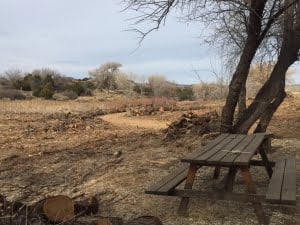
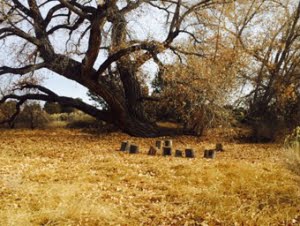
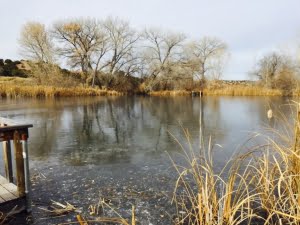
As we stroll down the trail, past the bird-watching stand and year-round pond, the ecologists point out where a work crew just finished removing six acres of these Russian olive trees. Piles of logs abounded where the trees once loomed overhead. As Yvonne Hickerson, IAE project lead, says, “When you go in and you take out six acres of trees that had been there for at least 20 years, it's gonna look like you got a bad haircut. But hair does grow back," she adds. "The site will look raw for a while." Native cottonwoods and willows provide a bit of shade, and continue to support wildlife at this site.
This cienega is well-loved by the Santa Fe community and visitors, so the team is developing signs and planning tours to help weekend visitors understand the restoration project “haircut” and why it was required to preserve this rare cienega. Many Santa Fe residents come here to bird-watch, enjoy shade from the large cottonwood trees, stroll through the 35 acres, or to check out the pond that is home to frogs, butterflies, birds and other animals. Ecological education programs for kids take place in the spring, and volunteer docents from the Santa Fe Botanical gardens give guided tours once a weekend in the spring and summer. The IAE Southwest office team, working with partners, are hosting a volunteer event on February 10 to remove even more of the Russian olive debris. Though Russian olive does not burn as well or as pleasantly as local pinon pine, IAE hopes some of the logs could be used as firewood or for carving. Control of other invasive weeds such as Russian knapweed, houndstongue, teasel, and bull thistle and retreating Russian olive stumps will continue in 2018.
A red-tail hawk gives us a goodbye call from above large cottonwood trees as we finish up our loop walk. Once the site reopens in May, and IAE and the Santa Fe Botanical gardens can begin to share the ecological importance of removing the Russian olive trees with the Santa Fe community.
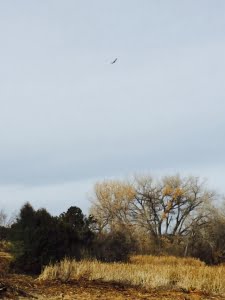
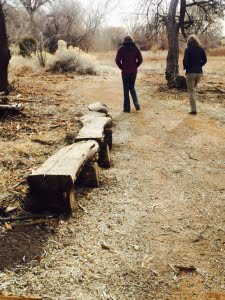
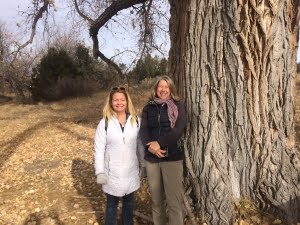
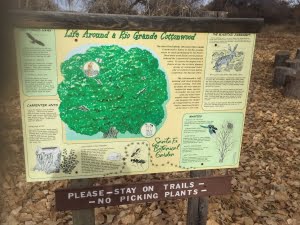

Restoration
Research
Education
Get Involved
Contact
Main Office:
4950 SW Hout Street
Corvallis, OR 97333-9598
541-753-3099
info@appliedeco.org
Southwest Office:
1202 Parkway Dr. Suite B
Santa Fe, NM 87507
(505) 490-4910
swprogram@appliedeco.org
© 2025 Institute for Applied Ecology | Privacy Policy
